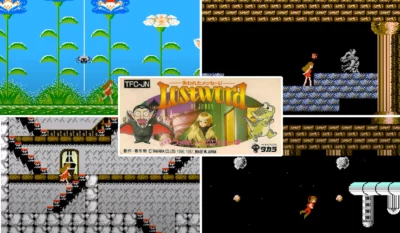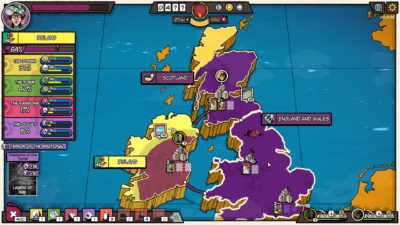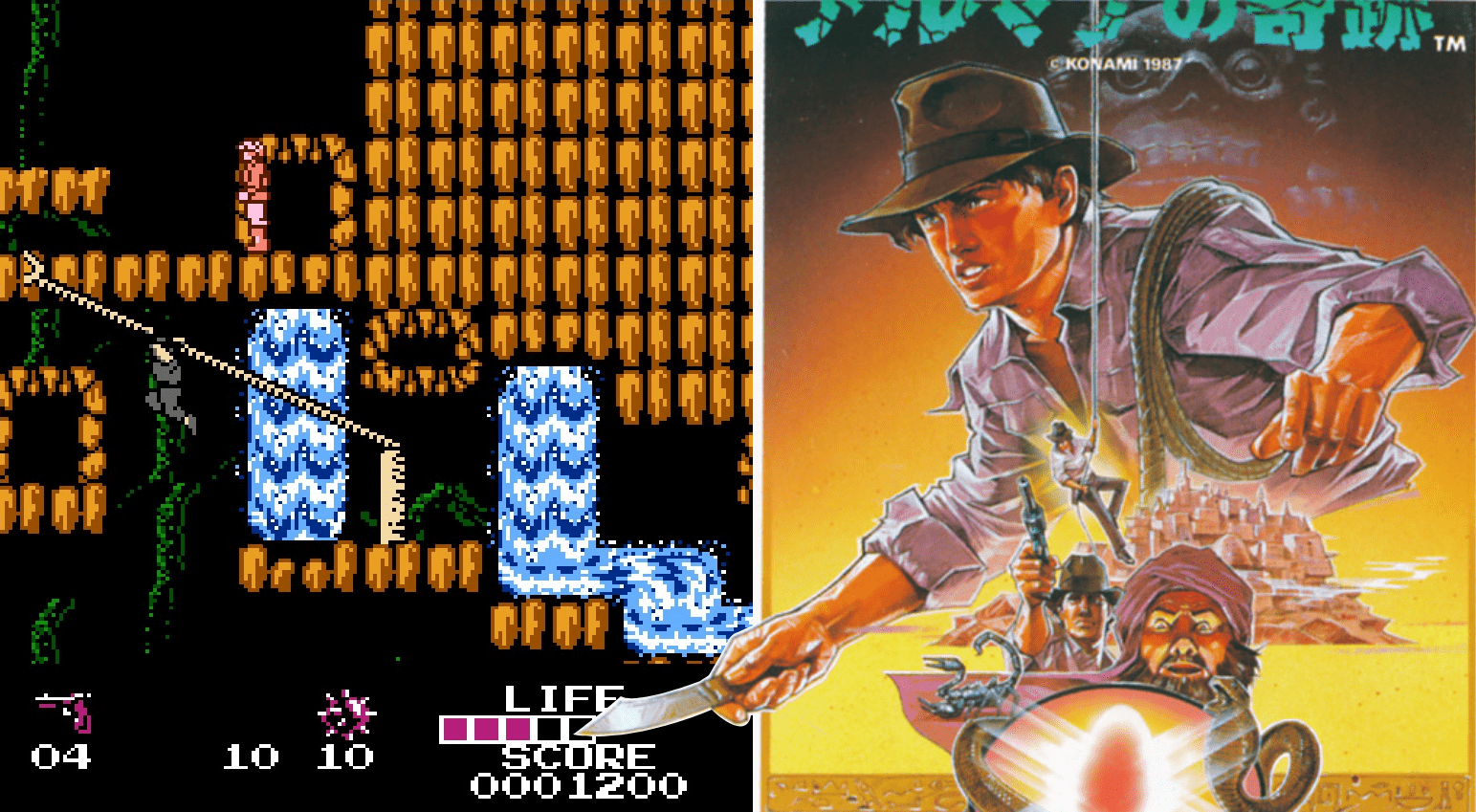
The best Indiana Jones game you’ve never played isn’t actually an Indiana Jones game at all. It’s Konami’s Arumana no Kiseki…
With the latest entry in Lucasfilm’s long-running Indiana Jones franchise Dial of Destiny just released in cinemas worldwide, movie-going gamers might feel an understandable urge to play at being Indy themselves for a little while.
If so, there have certainly been many officially licensed games for them to choose from down the years, from classic 1992 PC point-and-click adventure Indiana Jones and the Fate of Atlantis to 1999 3D Tomb Raider clone Indiana Jones and the Infernal Machine. An altogether better option, however, might be to play an Indiana Jones game which doesn’t actually have Indiana Jones in it.
Arumana no Kiseki (Miracle of Arumana) was released by Konami in 1987, exclusively for the Japan-only NES variant, the Famicom Disk System (FDS). To take a quick glance at the box cover-art, you would be forgiven for thinking it was actually an officially licensed Indiana Jones game – largely because it features a big picture of Indiana Jones on it. Except, of course, this isn’t actually Indiana Jones at all, oh no.
Instead, it is a daring archaeologist-adventurer of Konami’s own internal invention, named Kaito. A daring archaeologist-adventurer who just happens to dress exactly like Indiana Jones in crumpled open-necked shirt and trademark fedora hat, and who, by pure coincidence, is depicted in the same classic hand-drawn 1930s movie-serial poster style as Indy himself was on the posters for his original 1980s trilogy of movies.
The fact the game was never released outside of Japan could have any number of plausible reasons behind it. For one thing, it would have needed conversion from the FDS format to a standard western NES cartridge, which would have entailed altering the soundtrack somewhat, the FDS having extra on-board audio channel capabilities. The most common guess, however, is that Konami simply didn’t want their title to attract the attention of Lucasfilm’s American lawyers: although this does rather hinge upon the implausible assumption that American movie-studios didn’t possess any lawyers based in Japan.
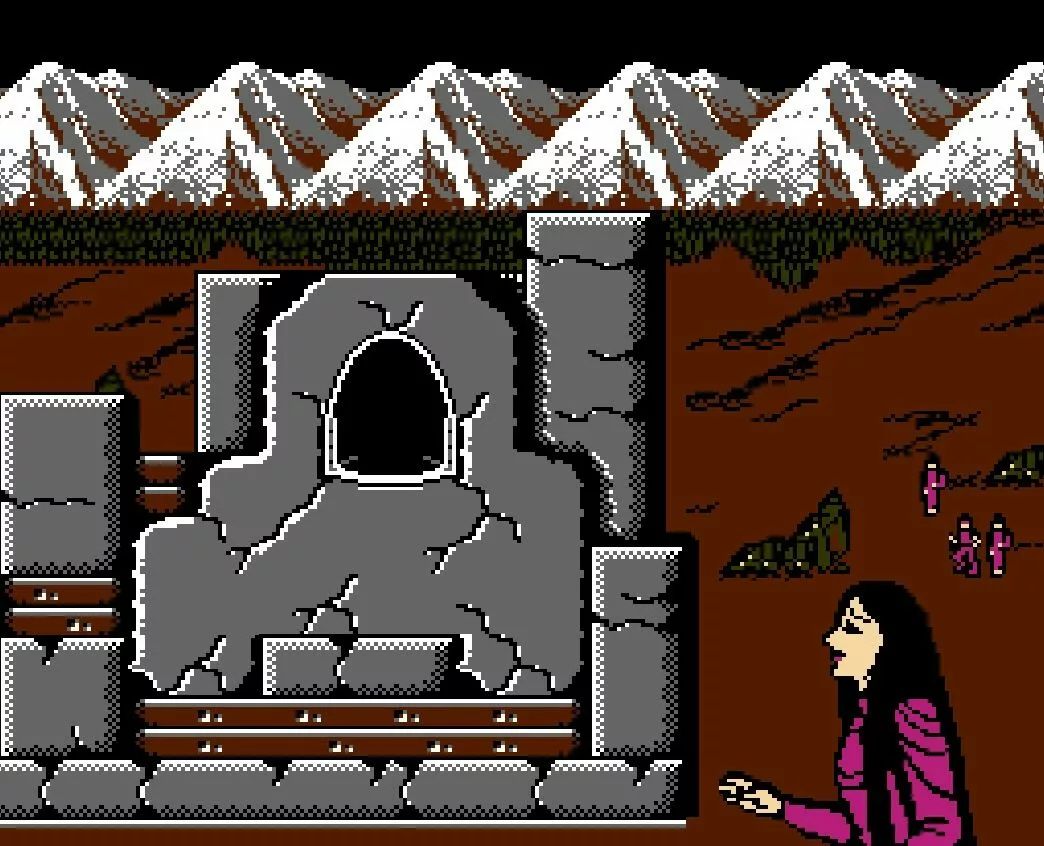
The atmospheric opening cut-scene. Definitely nothing like Temple of Doom. Credit: Konami.
The Big Grapple
The game itself was certainly of high enough quality to have seen a much wider release. An action platformer, the story revolves around the attempts of Indy – I mean Kaito – to retrieve a sacred Indian jewel, the ‘Arumana’ of the title, from a band of thieves and murderers serving an evil god who lives inside a sinister temple. This is entirely unlike the plot of the 1984 film Indiana Jones and the Temple of Doom, in which the title character has to retrieve a sacred Indian jewel from a band of thieves and murderers serving an evil god who lives inside a sinister temple.
To be fair, however, Konami’s own sacred stone also has the power to transform its victims into solid stone statues like victims of Medusa in Greek myth, so there is at least one small difference to be argued in a court of copyright law.
On the cover-art, Kaito is seen with a rope of some kind twirled around one shoulder, which could at first glance be taken for a whip. 1980s Konami already had one prominent whip-wielding hero in Simon Belmont from Castlevania, though, and the item in question was actually a grappling-hook, which provides the literal gameplay ‘hook’ to the platforming.
Kaito can run and jump like most platform protagonists, and is able to take out enemies – ranging from cultist soldiers to various poisonous cavern-beasts like snakes and scorpions – with throwing knives, bullets, bombs and mines (which can also blast away certain walls, revealing hidden passages filled with rare treasures like health-boosting amulets).
So far, the game plays (and looks) somewhere halfway between Konami’s other two main 8-bit action-platformer franchises of the day, Castlevania and Contra. Yet the level-design is far more vertically oriented than either of those two rivals, necessitating use of Kaito’s grappling-hook to reach higher regions which simply can’t be scaled by foot alone. Having latched onto a wall or platform with his hook, the rope rather bizarrely stiffens out into a kind of portable washing-line-type arrangement, meaning Kaito can then shimmy in physics-defying fashion up it to ledges above.
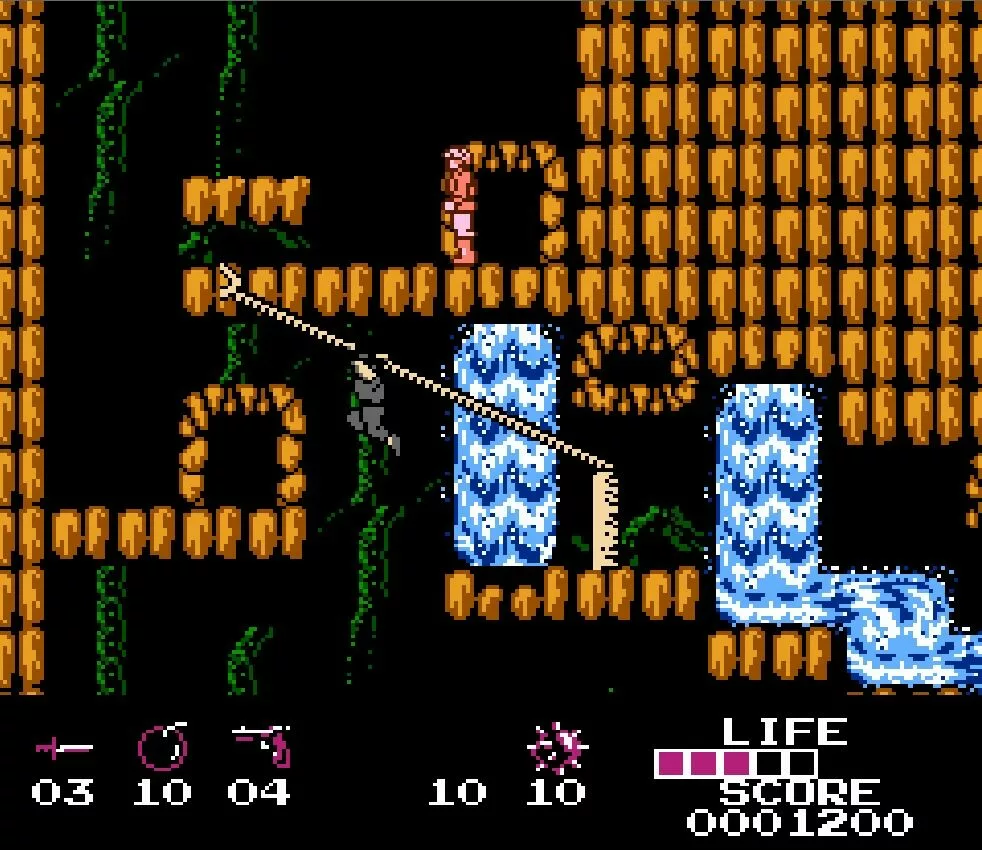
The grappling hook mechanic is fiddly yet surprisingly rewarding. Credit: Konami.
Money For Old Rope
At first glance, the other platformer Arumana no Kiseki most resembles is Capcom’s Bionic Commando, also released in Japan in 1987. As this game also features a gun-wielding man with a grappling-hook, you might perhaps initially be forgiven for thinking that Konami had pinched someone else’s idea once again here. Yet matters were actually the other way around.
Bionic Commando was created by Capcom employee Tokuru Fujiwara, who had previously worked for Konami, for whom he had helped design the 1983 arcade title Roc’n Rope, about an archaeologist who must ascend platforms whilst avoiding cavemen and dinosaurs. The protagonist’s chosen method of travel was a harpoon-gun, whose mechanics worked in more-or-less the same fashion as the grappling-hook later carried by Kaito in Arumana no Kiseki.
Fujiwara had long wished to make a sequel to Roc’n Rope but, now working for Capcom, did not possess the license, so made Bionic Commando instead, as a kind of spiritual sequel featuring different characters and a much more adaptable grappling-arm mechanic. So, if anyone was a victim of intellectual property theft in this particular respect, it was actually Konami!
Read more: Mystical Ninja | The Goemon games Konami never bought to the west
Then again, perhaps you could say Konami self-plagiarised themselves somewhat in the game. Besides lifting the grappling-mechanic straight from Roc’n Rope, there are several elements pinched directly from Castlevania too (the excellent FDS-enhanced soundtrack was the work of Kinuyo Yamashita, who also provided the music for the first Castlevania title).
Kaito’s throwing-knives are just like those of Simon Belmont, health is restored by eating chicken drumsticks, and the cave-bats which fly out at the player look suspiciously similar to the very same pixelated ones which inhabit Dracula’s castle. The skeletal mummies which collapse then resurrect themselves shortly afterwards share the precise same modus operandi as Castlevania’s red skeletons too, whilst the cultist soldiers look like the Soviet troops from Green Beret (also known as Rush’n Attack), but dressed in new uniforms. The characters’ generic ‘faceless’ look, too, is very much standard for Konami games of the time.
Grapple of Discord
Is the game worth actually playing, though? The answer is a resounding – if qualified – yes! The unusual vertical-oriented design of the levels, combined with the grappling-hook mechanic, make for a fun, exploration-based experience. You’re not just trekking from left to right all the time, as so often with games of this era, meaning you can to some extent make your own way through the levels, which feature both dead-ends and multiple routes through to the exit.
The game’s main strength, however, is also its main weakness. Sometimes you just need to be a little too precise with your grapple-aiming, leading to numerous repetitive situations in which you misjudge your aim, fall back down to the platform below, and have to repeat your grappling ad infinitum. When combined with the fact that enemies are constantly regenerating from background doorways, this simply ends up making the game too hard, in spite of Kaito’s (necessarily) generous energy bar.
Of the six levels on offer, this means the most enjoyable, as it is by far the most do-able: that it ends in an unexpected white-water rafting experience in which you have to throw knives or bombs into a giant water-dragon’s face also helps. If the rest of the game had simply been a little easier – or the grappling-mechanic a little more forgiving and less precise in its margins – this could have been a real classic rather than a minor one, perhaps even the basis for a full franchise series like Castlevania (or indeed Indiana Jones).
If you want to play Arumana no Kiseki today, you’re probably going to have to use an emulator, although in 2012 it seems an unauthorised version of the ROM was placed onto old repackaged NES cartridges and sold in the US as part of a limited-edition amateur homebrew release sold at game-fairs under the new and slightly mistranslated name, Miracle of Almana. Both these methods of distribution are legally dubious, of course, but given Konami’s own apparent disregard for such matters when it comes to respecting the copyright of Indiana Jones, I’m sure they won’t mind too much.


